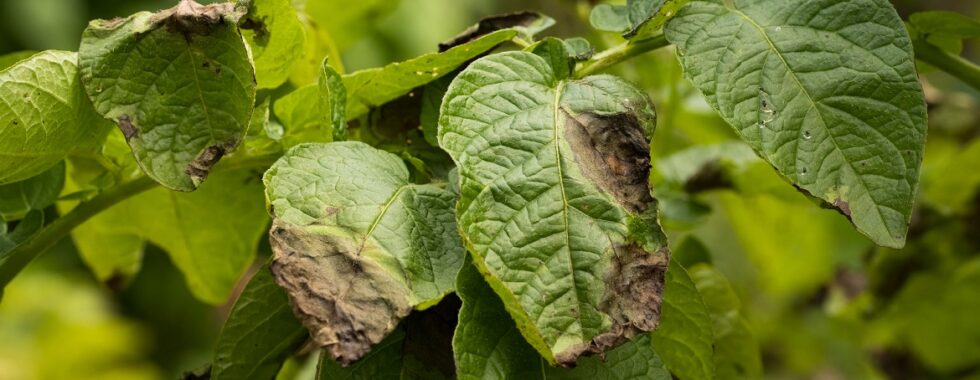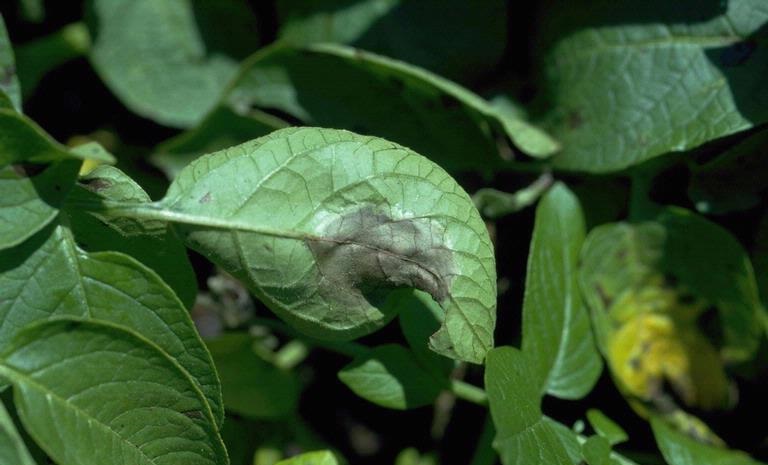Potato blight
Late blight is a destructive disease that primarily infects potatoes and tomatoes, but also other members of the Solanaceae family.
The causative pathogen for late blight disease is fungus-like oomycete (water mold), scientifically named Phytophthora infestans. In potatoes, the disease affects the leaves, stems and tubers.
Signs and symptoms of late blight infection in potato
The initial sign of infection is green or gray spots that develop on the old lower leaves of a potato plant. As the disease progresses, the lesions turn either brown or black and spread to leaves and stem tips, where moisture is higher.
In moist conditions, phytophthora infestans produces sporophores enclosed in sporangium on the exterior side of affected parts. The sporophores develop into white spores that are noticed at the edges of the lower surface of leaves. If left untreated, the disease spreads to all parts of the potato plant, causing a significant plant damage. Wilting leaves is a common symptom of highly infected plants.
On the other hand, infection of potato tubers occurs when the spores fall from leaves/stems into the soil. An infection starts at lenticels, tuber eyes, or cracks, resulting in purple, brown, or reddish tubers.
Late blight in potato (Phytophthora infestans)
Source: Howard F. Schwartz, Colorado State University, Bugwood.org
Optimum conditions for late blight development
Phytophthora infestans grows and thrives in cool and wet weather conditions. The pathogen survives at an optimum temperatures of 18⁰ – 22⁰,and humidity of <90%. Generally, changes that increase humidity, such as excess rainfall, cold nights, and fog, trigger the outbreak of the late blight disease.
Potential damages
Late blight disease causes low potato and tomato yields. The annual economic losses associated with late blight, in potato alone, are estimated at $3-5 billion.
How to prevent/minimize the infection
- Earthing up – earthing up entails heaping soil around the crop to protect the tubers from getting infected by falling spores.
- Crop rotation – the disease affects mainly the members of the Solanaceae family and specifically potato and tomato. Rotate potatoes with crops from a different family. This can help clear up the pathogen reservoirs.
- Proper field clean-up – In most farms, infectious oospores pass from one season to the next. Where such oospores are absent, infected tubers left out during harvesting do the transmission. It is, therefore, necessary to thoroughly clean up the field, burying cull potatoes, or carefully transport them for dumping.
- Ensure proper drainage and air movement in the farm to regulate air moisture, which might trigger the disease.
- Plant certified and late blight-resistant tubers.
- Maintain proper intervals between irrigations, in order to minimize the time in which leaves are wet.
- Regulate the use of nitrogen fertilizers, as they might result in excessive foliage and increase the exposure to the pathogen.
Treatment
The treatment of late blight in potatoes involves spraying the crop with foliar fungicides. Apply scheduled sprays, in order to avoid the disease from developing. Both protectant and systemic fungicides are available. Protectant fungicides create a protective coat on the stems and leaves to prevent infection, while systemic fungicides protect other plant parts from being infected. Crop must be sprayed before the infection occurs, because it is difficult to stop the spread of an existing disease.
Fungicides that are used against phytophthora infestans in potato include Ametoctradin, Benalaxyl, Benthiavalicarb- Isopropyl, Chlorothalonil, Copper hydroxide (for organic potato production), Dimethomorph, Mancozeb, Metalaxyl and some others.



